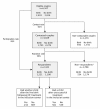Who does not participate in a follow-up postal study? a survey of infertile couples treated by in vitro fertilization
- PMID: 22824369
- PMCID: PMC3489673
- DOI: 10.1186/1471-2288-12-104
Who does not participate in a follow-up postal study? a survey of infertile couples treated by in vitro fertilization
Abstract
Background: A good response rate has been considered as a proof of a study's quality. Decreasing participation and its potential impact on the internal validity of the study are of growing interest. Our objective was to assess factors associated with contact and response to a postal survey in a epidemiological study of the long-term outcome of IVF couples.
Methods: The DAIFI study is a retrospective cohort including 6,507 couples who began an IVF program in 2000-2002 in one of the eight participating French IVF centers. Medical data on all 6,507 couples were obtained from IVF center databases, and information on long-term outcome was available only for participants in the postal survey (n = 2,321). Logistic regressions were used to assess firstly factors associated with contact and secondly factors associated with response to the postal questionnaire among contacted couples.
Results: Sixty-two percent of the 6,507 couples were contacted and 58% of these responded to the postal questionnaire. Contacted couples were more likely to have had a child during IVF treatment than non-contactable couples, and the same was true of respondents compared with non-respondents. Demographic and medical characteristics were both associated with probability of contact and probability of response. After adjustment, having a live birth during IVF treatment remained associated with both probabilities, and more strongly with probability of response. Having a child during IVF treatment was a major factor impacting on participation rate.
Conclusions: Non-response as well as non-contact were linked to the outcome of interest, i.e. long-term parenthood success of infertile couples. Our study illustrates that an a priori hypothesis may be too simplistic and may underestimate potential bias. In the context of growing use of analytical methods that take attrition into account (such as multiple imputation), we need to better understand the mechanisms that underlie attrition in order to choose the most appropriate method.
Figures

Similar articles
-
Seven out of 10 couples treated by IVF achieve parenthood following either treatment, natural conception or adoption.Reprod Biomed Online. 2016 Nov;33(5):560-567. doi: 10.1016/j.rbmo.2016.08.010. Epub 2016 Aug 22. Reprod Biomed Online. 2016. PMID: 27616620
-
The Devon Active Villages Evaluation (DAVE) trial: study protocol of a stepped wedge cluster randomised trial of a community-level physical activity intervention in rural southwest England.BMC Public Health. 2012 Aug 1;12:581. doi: 10.1186/1471-2458-12-581. BMC Public Health. 2012. PMID: 22849310 Free PMC article.
-
Consumers' experiences of back pain in rural Western Australia: access to information and services, and self-management behaviours.BMC Health Serv Res. 2012 Oct 11;12:357. doi: 10.1186/1472-6963-12-357. BMC Health Serv Res. 2012. PMID: 23057669 Free PMC article.
-
Age-related natural fertility outcomes in women over 35 years: a systematic review and individual participant data meta-analysis.Hum Reprod. 2020 Aug 1;35(8):1808-1820. doi: 10.1093/humrep/deaa129. Hum Reprod. 2020. PMID: 32696041
-
Clinical review 100: Evaluation and treatment of the infertile couple.J Clin Endocrinol Metab. 1998 Dec;83(12):4177-88. doi: 10.1210/jcem.83.12.5296. J Clin Endocrinol Metab. 1998. PMID: 9851748 Review.
Cited by
-
Men report good mental health 20 to 23 years after in vitro fertilisation treatment.BMC Public Health. 2015 Nov 25;15:1175. doi: 10.1186/s12889-015-2398-6. BMC Public Health. 2015. PMID: 26607065 Free PMC article.
-
Live birth outcome, spontaneous pregnancy and adoption up to five years after undergoing assisted reproductive technology treatment.Acta Obstet Gynecol Scand. 2017 Aug;96(8):954-959. doi: 10.1111/aogs.13139. Epub 2017 May 18. Acta Obstet Gynecol Scand. 2017. PMID: 28374421 Free PMC article.
References
-
- Littman AJ, Boyko EJ, Jacobson IG, Horton J, Gackstetter GD, Smith B, Hooper T, Wells TS, Amoroso PJ, Smith TC. Assessing nonresponse bias at follow-up in a large prospective cohort of relatively young and mobile military service members. BMC Med Res Methodol. 2010;10:99. doi: 10.1186/1471-2288-10-99. - DOI - PMC - PubMed
Publication types
MeSH terms
LinkOut - more resources
Full Text Sources
Medical

